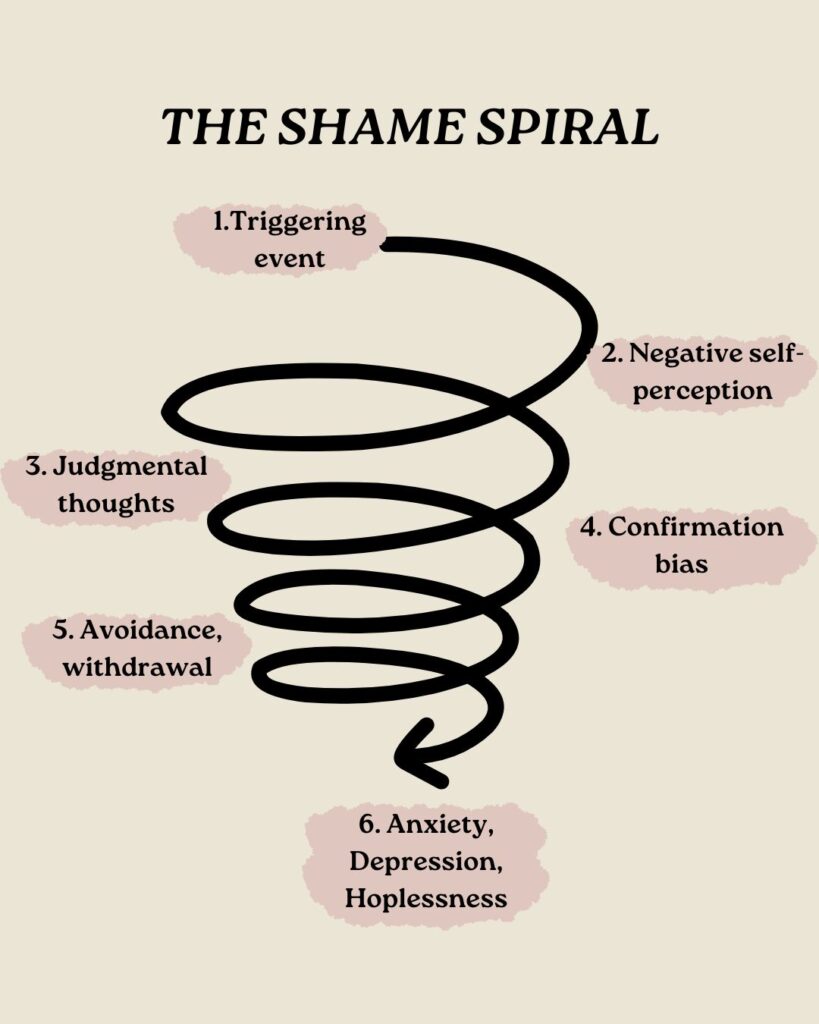Have you ever received negative feedback and immediately went into a mode of harshly blaming yourself thinking that you are a failure? Did you notice, then, how you suddenly turned into your own enemy bringing up all your biggest past mistakes? This process is called “a shame spiral”, that appears as a response to a perceived mistake, or failure to reach perfection. However, becoming aware of how shame is the root of your perfectionism and how it appears in your life can positively influence your mental health.
What is a shame spiral?
Let’s start with defining shame. What is shame? Freud links the feeling of shame to agony, the feeling that there is something wrong with yourself and it was exposed, leading to social exclusion. I partly agree with this view upon shame. Shame, is indeed, a deeply hurtful feeling, that can be associated with the feeling that there’s “something wrong” with you.
However, saying that “I feel a lot of shame now” is not a common phrase to hear. This phrase can sometimes be masked as “I am a failure”, “I am not good enough for this position”, “I knew I was going to fail this, considering how many times I failed before”, “They are all judging me for failing now, and think that I am not smart enough”. And that is how shame appears in our lives. It can appear, and it mostly does, every day, in all shapes and forms!
Now let’s get to the so-called “shame-spirals”. You might have heard of anxiety spirals, and they are quite similar. The stages of a shame spiral can be observed in the picture below, but I will give you an example to better understand it and to be able to spot it on your own when it appears.
You failed a difficult university exam for two times already, and you are very worried that you will fail it again. When the results for the third time come, you find out that you failed again. You start thinking of how incapable you are, and that you can’t do anything right. Then you start thinking about your parents, and how much you disappointed them again, and of your friends who passed the exam and who might be thinking that you are not smart enough.
You start paying attention to all the small gestures your friends are doing. Why didn’t they invite you to that party? They “definitely” think you are not smart enough to be part of their group. Then, you get into the avoidance stage. You stop inviting your friends out, isolating yourself, thinking that they don’t enjoy your company. You start thinking that maybe you are not able to finish this degree. You start catastrophizing.

The link between shame and perfectionism
Dr. Gershen Kaufman, a pioneer in the study of shame, describes perfectionism as a defending script against feeling shame. That means that an individual will start striving for perfection to avoid an encounter with the feeling of shame. Perfection scripts shape the self by striving to eliminate every perceived flaw. They demand excellence across all domains, yet no achievement is ever sufficient. The pursuit of perfection follows specific rules that need to be strictly followed, in order to avoid shame. By anticipating and controlling moments of shame, perfectionism attempts to compensate for a deep-seated sense of inadequacy—never feeling truly good enough. This reinforces the belief that every effort falls short, as there is always room for improvement. Ultimately, this cycle leads back to shame, making perfection scripts both self-restricting and self-reinforcing.
Changing identity scripts: A path to overcoming perfectionism
Perfectionism often manifests through deeply ingrained identity scripts – internalized patterns of self-talk and behavior that develop over time. These scripts shape how we interpret our experiences and relate to ourselves, particularly in situations involving performance, achievement, and self-evaluation. For perfectionists, these scripts involve harsh self-criticism, unrealistic standards, and persistent feelings of inadequacy. They are the ones dictating your shame spiral.
These scripts aren’t just thoughts or attitudes but represent complex patterns that connect our past experiences with present behaviors and future expectations. They emerge from our historical interactions with others and ourselves, changing into patterns that maintain perfectionism.
Steps to transform perfectionistic identity scripts
It may be challenging to work on the following steps without the support of a trained mental health professional as working with perfectionism shows resistance, but these steps can be followed as an introspection exercise and further analyzed within a therapeutic context.
1. Consciously observe your scripts
Begin by observing your inner dialogue in everyday situations. Pay particular attention to moments when you:
- Look in the mirror
- Make mistakes
- Interact with others
- Receive compliments
During these moments, notice what your inner voice says. Does it immediately search for flaws? Does it dismiss achievements? Does it compare your performance to an unachievable standard?
2. Identify your scripts and their patterns
Once you’ve observed these internal responses, work to accurately identify the type of script. Perfectionistic scripts often fall into three categories:
- Self-blame (“You should have known better”)
- Comparison-making (“Others would have done this better”)
- Self-contempt (“Nothing you do is ever good enough”)
3. Develop Internal “Good Enough” Standards
A crucial step in overcoming perfectionism involves developing an internal sense of what constitutes “good enough.” This means learning to:
- Adjust expectations based on context and circumstances (“Considering that I did not have a good night’s sleep, my performance was negatively influenced by this”)
- Set realistic standards that account for human limitations (“I worked every day this week, I am not able to do that during the weekend too.”)
- Trust your internal judgment rather than seeking external validation (“I will not prepare for the half-marathon all my work colleagues are, and I will do the painting course I always wanted to.”)
4. Creating Self-Affirming Alternative Scripts
Create new, self-affirming scripts that replace the perfectionistic ones. This process includes:
- Developing a new language of self-respect (“I will make myself a healthy meal every day and stop buying the premade meals.”)
- Establishing daily self-nurturing practices (“I will journal for at least 10 minutes every day.”)
- Learning to forgive yourself for perceived inadequacies (“It’s okay if I did not have time to listen to my friend’s story today, I was feeling overwhelmed.”)
Concluding remarks
Practicing the above-mentioned practices can support you into first “facing” your shame that was wearing the mask of perfectionism, then challenging it, and finally gaining control over it. Sometimes, perfectionists worry that by “getting rid” of their perfectionism, their performances will also drop. After having such a tight relationship with perfectionism that also brought up so many benefits, it is hard to let go. I know. However, those benefits came with huge costs that now outweighs them. So, with the presented practices, you can “get rid” of the dark side of your perfectionism. Get rid of the annoying inner voices that bring you down every time you want to celebrate.
